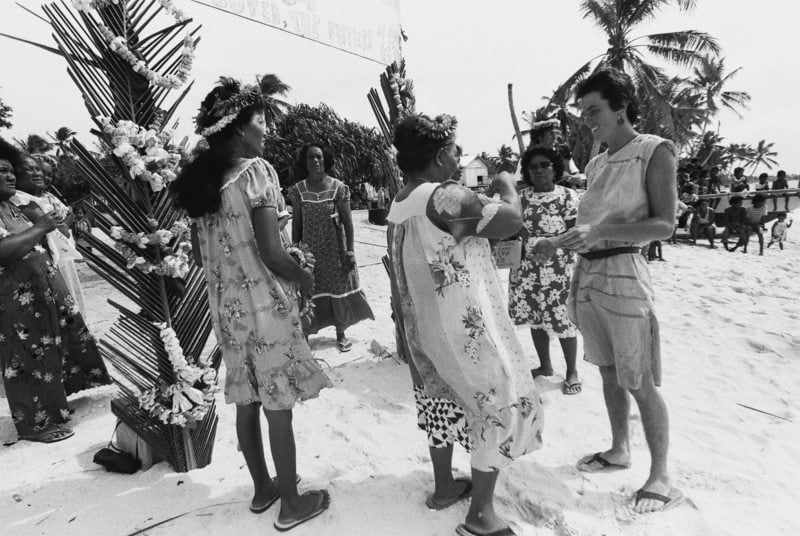On this International Day Against Nuclear Tests, Bunny McDiarmid, Executive Director of Greenpeace International, reflects on 46 years of fighting against nuclear weapons.

The Rainbow Warrior is in Rongelap to assist in the evacuation of islanders to Mejato. Rongelap suffered nuclear fallout in 1954, making it a hazardous place for this community to continue living in.
Looking back, one of the key moments that was to define both my professional and personal path was the moment I stepped off a boat onto the main island at Rongelap, a small atoll in the Pacific Ocean.
It was 17 May 1985 and I was 24 years old. On first glance, it appeared as if I had reached paradise; sandy beaches with coconut trees, water so crystal clear you could see the bottom for meters. And yet nothing was as it should be.
Waiting for us on the beach, with flowers, was the local community. The women held a banner reading ‘we love the future of our children’. And I was there with the crew of the Greenpeace ship to help them relocate. Their beloved island was making them sick.
In March 1954 the atoll received a massive amount of radiation when the US tested its most powerful nuclear device. The test was code-named ‘castle bravo,’ and the residents of Rongelap were given no warning and offered no protection. Radioactive fallout descended on the island. Falling for days, it dissolved into water supplies and contaminated the soil. The children played in the fine white ash that they thought was snow.
In the years that passed after the test, it became clear the island was no longer safe. The impact of radiation, impossible to clean, was revealing itself with time. The percentage of people contracting cancer skyrocketed, children were born severely deformed. They were left with no choice but to leave the island, with little hope of ever returning. The contrast between the beautiful setting and the tragic fate of residents is one that still breaks my heart when I think about it so many years later.
Today, 29 August, marks the International Day Against Nuclear Tests. And while every day during the past few months stands as a stark reminder as to why nuclear tests and nuclear weapons are so dangerous, today is a good day to reflect on the lessons we’ve learned.
In 1996, major states signed the Comprehensive Nuclear-Test-Ban Treaty, pledging to discontinue all nuclear testing. And although the treaty never entered into force, nuclear testing essentially screeched to a halt with its adoption. The treaty forged an international zero-tolerance stance against nuclear testing. The handful of nuclear tests conducted after 1996 received universal condemnation.
The only country to have performed nuclear tests in the 21st century is North Korea, completing 5 tests in the past 11 years.
Nuclear war, it seems, is not longer inconceivable, a taboo. It has become thinkable again.
North Korea has threatened to attack the US territory of Guam, in the Pacific Ocean. President Trump, who is the ultimate commander of the US’s extensive nuclear arsenal, has threatened North Korea with ‘fire and fury’. The threat of nuclear attack has become a bargaining chip, a threat spoken about out so easily and lightly.
Both sides are dangerously flirting with a conflict that, if indeed started, no one can say for sure how it will finish. But it will likely cost the lives of thousands, if not millions. These latest developments fill me with anger and even despair. But on most days, I try to see the positive. At least the veil has been lifted, and once again we are reminded how high the stakes are.
These weapons of mass destruction are designed for one purpose only: war. Their use, and even the threat of their use, poses an existential threat to all life on our precious planet.
The solution to the current crisis is clear: negotiation and diplomacy. Only this can bring us back from the brink.
A historic milestone was made in July of this year at the United Nations in NY, when 122 countries voted in favor of a new treaty banning nuclear weapons. In September, the treaty will open for signature and shortly after is expected to enter into effect.
Nuclear armed states and many of their allies boycotted the treaty, doing all they could to try and derail the negotiation. They failed, but their absence is significant. Unless a country ratifies the treaty, it is not bound by it. Nevertheless, the importance of the treaty is enormous, and it will make it harder for the proponents of nuclear weapons to describe them as a legitimate and useful means to provide security.
The treaty sets the benchmark for a world where nuclear weapons are considered as a threat to security, not an avenue to it.
In this time where the threat of war has become thinkable again, and the world’s governments must use it as an impetus to come to their senses, and disarm.
Take action now and tell the Australian Government to sign the Nuclear Weapons Ban Treaty!


